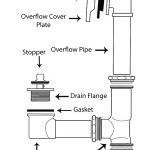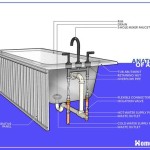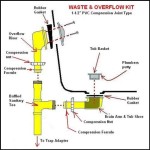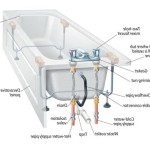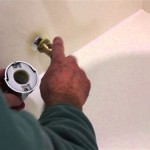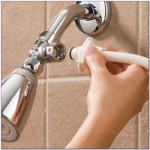Bathtub Faucet Plumbing: Essential Aspects
Installing and maintaining a bathtub faucet is a task that requires proper knowledge of plumbing. Understanding the essential aspects of bathtub faucet plumbing can ensure a successful installation and prevent future leaks or malfunctions.
Components of a Bathtub Faucet
A bathtub faucet typically consists of several components:
- Spout: The part that dispenses water from the faucet.
- Handle(s): Controls the flow and temperature of the water.
- Aerator: Attaches to the spout and helps reduce splashing and water consumption.
- Cartridge: A cylindrical valve located within the faucet body that controls water flow.
- Supply lines: Flexible hoses that connect the faucet to the water supply.
Types of Bathtub Faucets
There are different types of bathtub faucets available based on their design and installation method:
- Wall-mounted: Installed directly onto the wall behind the tub.
- Deck-mounted: Installed on the rim of the bathtub.
- Freestanding: A separate unit that stands independently next to the tub.
- Roman tub fillers: Used for freestanding bathtubs, with a long spout and handles mounted on the floor or tub deck.
Plumbing Considerations
Before installing a bathtub faucet, it's crucial to consider the following plumbing aspects:
- Water Supply: Ensure the existing water supply lines are compatible with the new faucet. This includes the type of pipes (e.g., copper, PEX) and the water pressure.
- Water Temperature Control: The faucet should have a mixer valve or thermostatic valve to control the water temperature.
- Drainage: The bathtub should have a proper drain and overflow system to prevent water from overflowing.
Installation Process
Installing a bathtub faucet typically involves the following steps:
- Shut off the water supply.
- Disconnect the old faucet and supply lines.
- Install the new supply lines onto the faucet.
- Mount the faucet onto the bathtub or wall.
- Connect the supply lines to the water supply.
- Turn on the water supply and check for leaks.
Maintenance and Troubleshooting
To ensure the longevity and proper functioning of the bathtub faucet, regular maintenance is essential:
- Clean the faucet regularly to remove mineral deposits.
- Replace the aerator periodically to prevent clogging.
- Check for leaks around the faucet base and supply lines.
- If any problems occur, consult a licensed plumber for professional assistance.
Conclusion
Understanding the essential aspects of bathtub faucet plumbing is crucial for a successful installation and proper maintenance. By considering the components, types, plumbing considerations, installation process, and maintenance techniques, homeowners can ensure their bathtub faucet is functioning optimally, providing years of trouble-free use.

Installing A Tub Faucet Fine Homebuilding

Learn How To Remove And Install Various Tub Spouts

Installing A Tub Faucet Fine Homebuilding

Help Water Running To Tub Spout And Shower Head Simultaneously Plumbing Diy Bathroom

Learn How To Remove And Install Various Tub Spouts

Install A 1 Handle Tub And Shower Faucet Rona

Shower Faucet Installation Diy Plumbing

How To Fix A Leaky Bathtub Faucet 6 Ways Stop Drips

How To Install Bathtub Shower Faucet Diy Step By Part 5
Plumber Checks Bathtub And Faucet After Installation In Mississauga Mister
Related Posts

